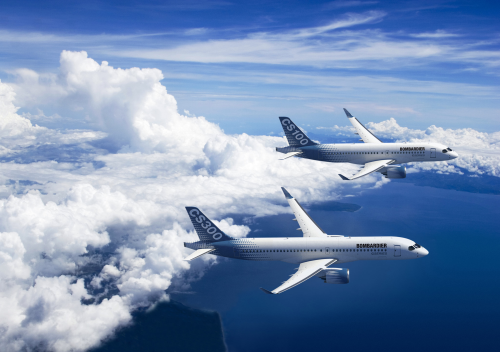
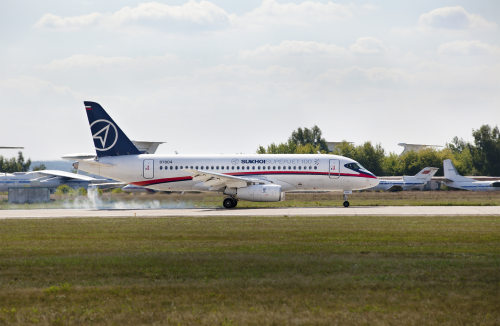
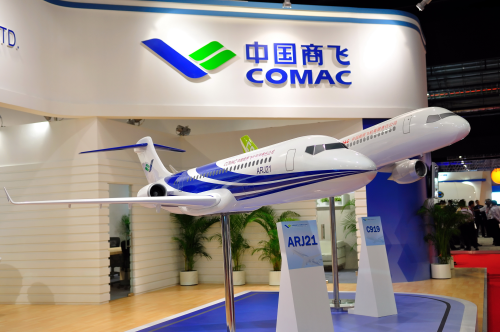
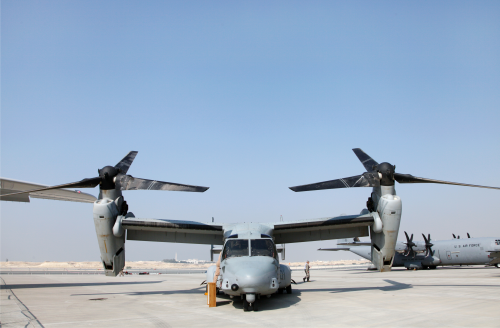
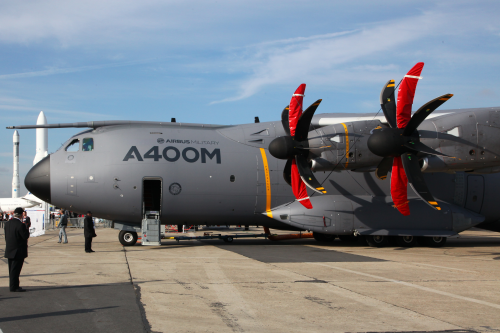
In the second part of George Marsh's article he looks at recent developments at challengers to Boeing and Airbus.
Challengers
However, there are several aviation players aiming to challenge the all-powerful duopoly. Highest in profile is Bombardier Aerospace whose CSeries challenger first flew last September With seating capacities of 100-125 for the initial CS100 model and 120-145 for the larger CS300, the type could make inroads at the lower end of the duopoly’s narrowbody market, if the aircraft proves to be as economical as promised.
A step up in fuel efficiency is partly due to composites, which account for some 45%wt of the aircraft and include the wing, most of which is fabricated at Bombardier’s Belfast, UK, centre of composites excellence. (The fuselage, however, is aluminium-lithium.) Much is also down to the PW1000G Pure Power engine, in which the large front-end fan is driven via a gearbox at optimum speed. Due to programme delays, Bombardier now expects service entry to take place in two years’ time. One delaying factor is the complex flight control software needed for this fly-by-wire aircraft. After a slow start to flight testing, Bombardier is now using three flight test vehicles with two more expected this year. A new final assembly facility for the aircraft in Mirabel, Canada, is almost complete. Although many potential operators are waiting to see if the airliner will meet its low operating cost expectations, Bombardier has firm commitments for over 200 aircraft. Stretching Bombardier Aerospace’s resources is the parallel development of its Learjet 85 business jet. This has an all-composite airframe, including the fuselage much of which is being manufactured in Mexico using an out-of-autoclave process. The composite wing is being produced in Belfast, basically by the same patented resin transfer infusion process, carried out in an autoclave that is used for the CSeries wing. A leading driver for composite adoption has been part count reduction, including the ability to lay up and co-cure skin panels complete with integral stringers and other stiffeners. This first of the Learjet family to be virtually all-composite is due to make its maiden flight imminently, following a nine-month delay due to manufacturing issues with the composite fuselage. Accelerated flight testing will utilise five flight test aircraft. The Canadian airframer has a significant competitor of its own in the regional jet market. Brazil’s Embraer is joining the fray with a second generation of its popular 175 E-jet family, in which composites are likely to figure, though to an unknown extent at present. Publicly launched at last year’s Paris Air Show, the EMB175E2 will be an upgrade of the existing EMB 175 family. Like the CSeries, the A320neo and the Japanese MRJ, the new Embraer will have geared turbofan engines from Pratt & Whitney.
Russia, too, has chosen the narrowbody arena in which to reinvigorate its civil aircraft manufacturing credentials. Its United Aircraft Corporation MC-21, a series of three short-to-mid range twin-engined narrowbody jets to seat 150-212 passengers, is approximately a third composite by weight. This, along with PW1000G Pure Power engine technology and significant western system content should, its makers expect, help it attract customers outside Russia as well as inside. UAC is aiming for a fuel efficiency advantage of 10-15% over equivalent Airbus and Boeing products, thanks in part to a claimed 15% less structural weight. Such metrics, if achieved, would all but guarantee outside airline interest, but inclusion in UAC’s package of international certification, compliance with ICAO environmental requirements and a wider cabin should further tempt operators who might also be considering A320neo, B737Max, CSeries and possibly China’s COMAC C919 types. With commitments for nearly 300 aircraft so far, UAC is progressing towards a first flight in 2015-16, deliveries being due to commence some two years later. Further ahead in the game, however, is UAC’s Superjet 100 regional jet competitor. Under development since the year 2000 in co-operation with Boeing, the Superjet 100 first flew in May 2008 and has significant composite content, including a wing manufactured using a non-autoclave infusion technology (also used for the MS-21 wing). The aircraft has been designed deliberately to meet western aircraft standards and incorporates a number of western systems. A long-range version of the jet made its first revenue flight in March. Russia’s Antonov is yet another contender with its An148 and An158 regional jets. China, too, aims to challenge western airliner dominance with two programmes, the Commercial Aircraft Company of China’s (COMAC) C919 and AVIC Commercial Aircraft’s (ACAC) ARJ21, but composites now feature less than was first intended. Development of ACAC’s ARJ21 regional jet has been slower than expected since its maiden flight in 2008, thanks in part to a requirement for certification to FAA standards so that the aircraft can be marketed in western countries. Several of the aircraft’s systems are western and, under a collaborative agreement with Bombardier Aerospace, ACAC hopes to incorporate more composites in its 105-seat stretch of the baseline -700 model, dubbed the ARJ21-900. For example, static loading tests were recently carried out on a composite winglet. Initial plans to make COMAC’s 158-seat C919 jet largely composite have been shelved as this would have further delayed a programme that is already late, with a first flight now expected late next year. Nevertheless, parts of the tail and certain movable structures are understood to be composite. Reports suggest that restricted access to aerospace-grade carbon fibre has been a constraining factor, though this will probably be overcome eventually by China setting up to produce its own. There was much interest in the aircraft at the recent Singapore Air Show, and COMAC has orders for some 400, albeit mainly from Chinese operators. Final assembly of the first aircraft should be completed in Shanghai late this year, with a maiden sortie planned for 2015.
Nor can Japan be left out of the reckoning. Its entry into the 70-90 seat market, the Mitsubishi Regional Jet (MRJ), is now expected to fly next year, with 2017 targeted for service entry. Its primary aerostructure is reported to be 10-15% composite, with the main concentration around the tail. First customer is the national airline ANA while, among other takers, Sky West has notably signed up for 100 MRJ90s.
Vertical
One type of aviation where low weight is absolutely top priority is vertical lift. That is why reinforced plastics account for an ever growing proportion of helicopter structures, both airframe and rotors, but the new breed of tilt rotor machines, like the military Bell-Boeing V22 Osprey and the civil Agusta-Westland AW609, are even more dependent.
Osprey, now in service with US forces, is 43%wt plastic, having an extensively composite airframe as well as the two prop-rotors, making the aircraft about 25% lighter than if it had been made wholly from metal. Composites are key in other ways too. Militarily, they support agility and a 300mph-plus performance that no conventional helicopter can achieve, ballistic tolerance, low radar profile and resistance to laser designation. Given levels of part integration resulting from two decades of composites development, they can be cheaper to produce and maintenance costs are lower thanks to high fatigue tolerance. Some 250 Ospreys have now been delivered to the US military of a total of almost 450 due. Further multi-year buys could follow while exports to Israel, Japan and other countries are in prospect. Reinforced plastics are likely to figure to an even greater extent in the next-generation tilt rotor, now in its early gestation. The highest-profile team so far to announce its intention to bid for the US military’s Future Vertical Lift requirement is a Bell Helicopter/Lockheed Martin partnership with the Bell V-280 Valor. Meanwhile, Agusta Westland’s commercial AW609 machine, with its pressurised cabin in a composite fuselage as well as plastic wings and other structures, is continuing with its flight test and certification programme, which has clocked nearly 1,000 hours using the first two prototypes, shortly to be joined by two more. Certification is now expected by 2017. Despite the fact that one-time partner, Bell, became discouraged about market prospects and left the programme, Agusta and Westland are confident that, provided costs are contained, the aircraft can appeal to offshore and gas interests operating to ever more remote deepwater installations, plus search and rescue and other specialist operators. Vertical lift is not the sole prerogative of open-rotored craft, as the British Harrier ‘jump jet’ showed and as its American successor is doing also. The Lockheed Martin F35 Lightning II Joint Strike Fighter is 35% composite, with largely plastic fuselage and wings incorporating carbon/epoxy and bismaleimide composites along with fibre mat and other stealth materials. This fifth-generation fighter was also the first series-produced aircraft to have structural nanocomposites. Following a protracted flight test and development phase that involved 20 aircraft, the much criticised programme is now delivering aircraft to the US forces and has started to deliver to international customers, including the UK which, like several others, is an industrial partner on the aircraft‘s development. With its short take-off and vertical landing (STOVL) capability, the plane is said to provide a step improvement in combat capability over existing fighters like the F22 Raptor (24% composite) and France’s Dassault Rafale (28%). Even the highly capable Eurofighter Typhoon, with its 70% composite shell, lacks the vertical lift capability of the F35. Military aviation continues to harness composites as a primary key to performance. The move towards unmanned aviation is seeing the emergence of remotely piloted aircraft that are predominantly composite while, at the other end of the size spectrum Europe’s latest military transport now entering service, the Airbus A400M, is extensively (30%) plastic too.
In the first part of George Marsh's article he looks at recent developments at established rivals Boeing and Airbus.
This article will be published in the May/June 2014 issue of Reinforced Plastics magazine.
The digital edition of Reinforced Plastics is distributed free of charge to readers who meet our qualifying criteria. You can apply to receive your free copy by completing this short registration form.






